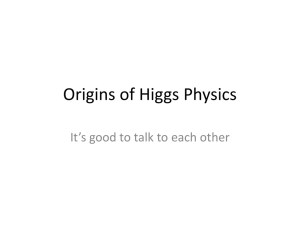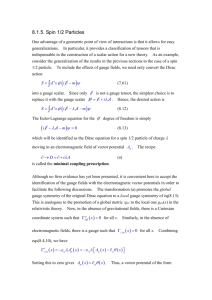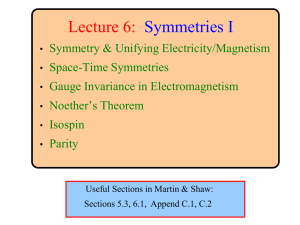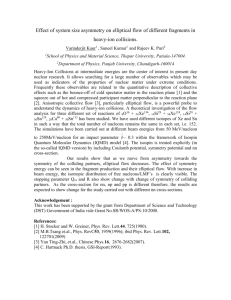index
advertisement
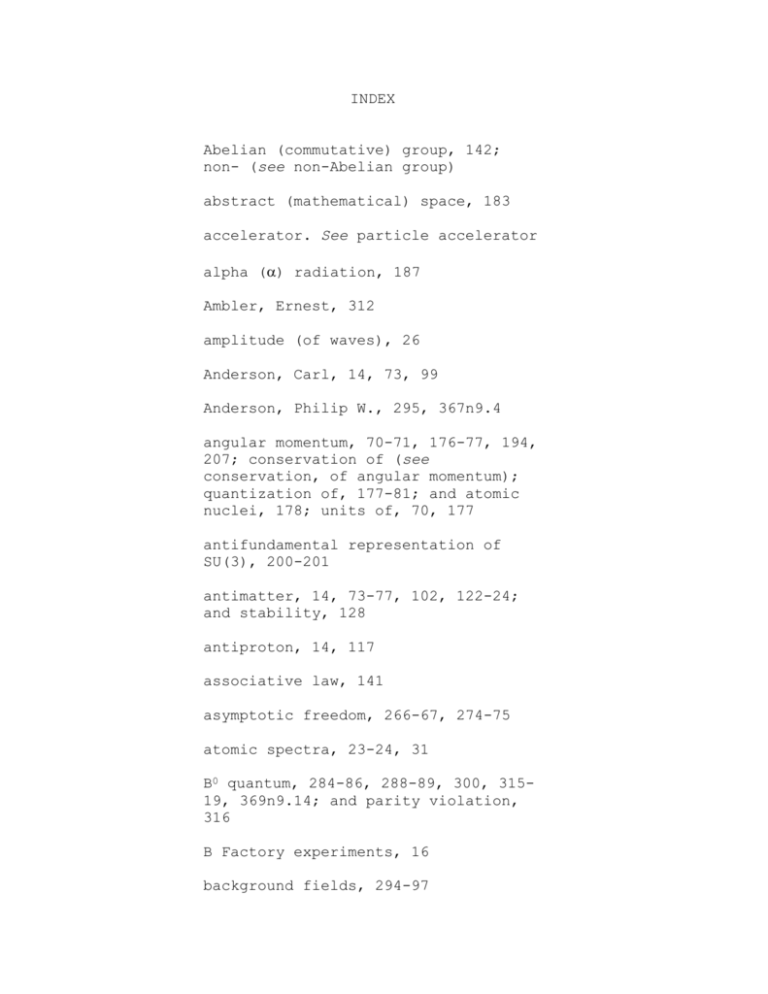
INDEX Abelian (commutative) group, 142; non- (see non-Abelian group) abstract (mathematical) space, 183 accelerator. See particle accelerator alpha () radiation, 187 Ambler, Ernest, 312 amplitude (of waves), 26 Anderson, Carl, 14, 73, 99 Anderson, Philip W., 295, 367n9.4 angular momentum, 70-71, 176-77, 194, 207; conservation of (see conservation, of angular momentum); quantization of, 177-81; and atomic nuclei, 178; units of, 70, 177 antifundamental representation of SU(3), 200-201 antimatter, 14, 73-77, 102, 122-24; and stability, 128 antiproton, 14, 117 associative law, 141 asymptotic freedom, 266-67, 274-75 atomic spectra, 23-24, 31 B0 quantum, 284-86, 288-89, 300, 31519, 369n9.14; and parity violation, 316 B Factory experiments, 16 background fields, 294-97 bare electron charge, 82, 263, 341 Barkov, Lev, 286 baryon, 132, 134-5, 267; , , , and , 134, 192-94; +, 204 Berners-Lee, Tim, 337 beta decay, 14, 99, 253, 367n9.1; of cobalt-60, 312, 368n9.9 blackbody, 356n3.6; radiation, 31 Bohr, Neils, 51 Bose, Satyendra Nath, 71 boson, 71, 178; and supersymmetry, 347 bottom (b) quark, 117, 129 broken symmetry. See hidden symmetry Brookhaven National Laboratory, 15, 100, 105, 204 Bryn Mawr College, 170 bubble chamber, 93 Budker Institute, 286 Cartesian coordinate system, 154, 176 Casimir effect, 86 Casimir, Hendrik, 86 causal connection, 218 CDF experiment, 117 CERN, 14, 103, 112, 120, 252, 273, 320, 327-28, 337 Chadwick, James, 187, 364n7.8 Chamberlain, Owen, 14 charged current interaction, 108-9, 115-16, 251 charmed (c) quark, 105-16; decay 126, 129 cheating term, 223-24, 239-43, 25556, 270, 277 classical theories, 51 clock arithmetic, 146 closure (of groups), 141 cobalt-60, 312 color charge, 13, 57, 122, 130-32, 266-69, 355n2.4; and representations of SU(3), 269 color space, 268 commutation (of groups). See Abelian complex: dimension 150-53, 161-67; exponential 359n4.11; multiplication, 362n6.4; number 150-51, 209-10, 358n4.10 (size of, 151, 209-10) Compton, Arthur, 33, 68 Compton scattering, 68 conduction electrons, 292, 360n4.15 conductor, electrical 292, 360n4.15 confinement, 130 conjugate quantities, 43 conservation: of angular momentum, 176-66, 207; of electric charge, 230, 248; of energy, 20, 44, 48, 72, 99, 126-28, 170, 173, 215, 219, 249, 357n3.11, 359n4.12, 359n4.13; of momentum, 172-74; of nuclear isospin, 192-94 conserved quantity, 170-74 continuous group. See group, continuous cosmology, 133 Coulomb, Charles, 51 Coulomb’s law, 171, 176 coupling, 57; space-time property of, 57, 69; running, 86-87, 275, 342-47; strength, 57, 66, 69, 228, 317, 343 Cowan, Clyde, 100 CP violation. See matter/antimatter asymmetry Cronin, James, 15 D0 experiment, 117 Davis, Ray Jr., 105 Davisson, Clinton, 35 de Broglie, Louis-Victor, 34, 50 de Broglie relation, 34, 37, 288-89 derivative, 46, 214-16, 219-22, 239, 270 detector, 337 determinism, 42 deuterium, 188 differential cross section, 64 differential equation, 46 Dirac, Paul, 51, 73, 358n4.9 Dirac equation, 73-77, 186 discrete symmetry. See symmetry, discrete Doublet, weak isospin. See generational doublet effective mass, 292-94 eightfold way, 94-98, 135-37, 140, 195-204, 267, 339 Einstein, Albert, 2, 3, 7, 15, 17, 19-22, 32, 34, 71 electric charge 9, 11, 30, 52-53, 121; and coupling strength, 228; and the gauge principle, 227, 342; relative strength of, 287-88; and weak hypercharge, 290 electrical conductor. See conductor, electrical electromagnetic: field, 30, 51-53, 54, 57; force, 6, 7-9, 16, 57, 62, 66, 136, 227, 339 (range of, 9, 289, 293); interaction (see electromegnatic force); interaction and the gauge principle, 224-28, 342; interaction and Abelian gauge structure, 258 electron microscopy, 36 electron neutrino. See neutrino, electron electron-volt (eV), 21, 356n3.3 electroweak: force, 7; theory, 54; scale, 335, 350; unification, 285 Elegant Universe, The, 355n2.1, 360n4.16 energy conservation. See conservation of energy exchange forces, 55-57 exercise rotations, 154-56 experimental uncertainty, 369n9.15 exponential notation, 353 Faraday, Michael, 70, 218, 357n4.1 Fermi, Enrico, 49, 71, 100 Fermi National Accelerator Laboratory (Fermilab), 103, 116-117, 119, 324, 328 fermion, 71, 119, 178; and supersymmetry, 347 Feynman, Richard, 3, 51, 59, 74, 80, 358n4.5 Feynman diagrams, 59-65, 262 fields, 51-54, 357n4.1 Finnegan’s Wake, 95, 200 Fitch, Val, 15 flavor: changing, 128; lepton 117; physics, 117; quark, 117, 355n2.4; space, 202-3 force field. See fields fourth generation, 104 frequency (of waves), 26 Friedman, Jerome, 97 Fritzsch, Harald, 266 fundamental representation of SU(3), 200-201, 366n8.8 funding for particle physics research, 4 GF, 318 gs (strong interaction coupling strength), 266, 270-71, 275 Gamow, George, 356n3.4 Gargamelle experiment, 112, 252 Garwin experiment, 314-15 Garwin, Richard, 314 gauge field, 269-71 gauge freedom, 226 gauge principle, 222-28, 277 gauge theory, 26, 30, 84, 208-282, 328-29; and massive gauge fields, 290-91 Gell-Mann, Murray, 94, 195, 200, 266 general relativity, 22, 170, 348, 355n2.3 generation, 101, 110-15, 118, 340 generational doublet, 243, 278 generational pattern, 108, 110-15, 341-42 generator. See Lie group, generators of GeV, 356n3.2 GIM mechanism, 113-14 Glashow, Sheldon, 107, 286 Glashow-Salam-Weinberg (Standard) Model of electroweak interactions, 285 global invariance. See symmetry, global gluon, 120, 121-22, 125, 271-73, 295, 343 grand unification, 7, 87; scale, 350 gravitational: charge (see mass and gravitational charge); field, 51; force, 6, 10-11, 14 (range of, 11; relative strength of, 288) graviton, 120 Greene, Brian, 355n2.1, 360n4.16 Gross, David, 266 group: Abelian (see Abelian group); axioms, 141-43; continuous, 148; identity element, 142; infinite, 147; inverse, 143; operation, 140; theory, 95, 140-47 gyromagnetic ratio, 88 hadron, 131 handedness. See parity and spin Heisenberg uncertainty principle, 3644, 56, 64, 67, 79, 359n4.12, 370n10.5; statement of, 42 Heisenberg, Werner, 23, 36, 50, 189, 195 hidden symmetry, 4, 297-99, 301-2 Higgs: boson 121, 124, 303-5, 325-28, 329-332, 347 (and supersymmetry, 348); doublet, 300-306; field 3, 29497, 300-306, 317, 329, 339, 351; mechanism, 330-31; potential 302-3, 317, 329-30; vacuum expectation value, 329 Higgs, Peter, 295, 352 high-energy electron-positron linear collider. See Linear Collider Hofstadter, Robert, 36, 97 HTML, 337 Hunting of the Quark, The, 360n5.2 hypercharge: strong, 198; weak, 28990, 300 i (square root of –1), 150-51 identity element. See group, identity element Illiopoulis, John, 113 imaginary number, 151 infinite group. See group, infinite interaction, 70; strength (see coupling strength) interference: of waves, 25, 35, 38; quantum- mechanical, internal symmetry space, 194, 204-7, 244, 253, 261, 277; of color 269 intrinsic parity. See parity, intrinsic invariance. See symmetry inverse element. See group, inverse inverse square force, 9, 11, 52 isospin: doublet (see generational doublet); nuclear (see nuclear isospin); weak (see weak isospin) isospin space: and local phase invariance, 239; nuclear, 191-95, 202, 234-37, 281; weak, 243-44, 278 (and the Higgs doublet, 300-301) isotope, 188 J/ particle, 105-8, 116; decay 126 jet, 120, 366n8.9 Joule, James Prescott, 357n3.11 Joyce, James, 95 kaon, 15, 136-7 Kendall, Henry, 97 KEK, 16 KeV, 356n3.2 kinetic energy, 19-20, 34, 44, 279 Klein-Gordon equation, 72, 77 Kobayashi, Makoto, 102, 360n5.4 Koshiba, Masatoshi, 105 Lamb, Willis, 94, 98 Lamoreaux, Steve, 86 Large Electron-Positron (LEP) Accelerator, 273, 320, 327 Large Hadron Collider (LHC), 328, 331-32, 335, 349-50 Lawrence, E. O., 349 Lazuras, 339 Lederman, Leon, 100, 116, 368n9.11 Lee, T. D., 309 left handed particle, 309 lepton, 14, 98-105, 125; flavor (see flavor, lepton); mass and hidden symmetry, 305-6 Lie algebra, 158-61, 165, 195, 240, 265; and the strength of interactions, 343; and the strong nuclear interaction, 272-74; and the weak nuclear interaction, 259-60 Lie group, 95, 140, 147-68, 212-13, 234, 339; and the gauge principle, 238-43; generators of, 154-57, 175, 195, 239, 255; and Noether’s theorem, 174-6, and quantum-mechanical phase, 231-38; representations of, 96, 196 Lie, Sophus, 95, 140 lifetime tag, 130 Linear Collider, 330-32, 335-36, 34950, 369n10.3 Liquid Neutrino Scintillation Detector (LSND) experiment, 104 local invariance. See symmetry, local localization, 37-39 magnetic field, 88 Maiani, Luciano, 113 Maskawa, Toshihide, 102, 460n5.4 mass: effective (see effective mass); gravitational charge and, 10-11, 46, 51, 57, 124-25; gauge theory and, 290-91; Higgs field and, 299-306; illusion of, 306; shell, 57; weak force and, 121 mass-energy, 19-21 mathematical group. See group matter/antimatter asymmetry, 15, 1023, 137, 340 Maxwell, James Clerk, 6, 30, 51 Mayer, Julius Robert, 357n3.9 Melissinos, Adrian, 85 meson, 131, 135-37, 267; K (see kaon); (see pion) MeV, 356n3.2 Michelson, Albert Abraham, 18, 19 Mills, R. L., 216 minimal interaction vertex, 65-70, 229, 247, 256-57, 261, 270-72, 278, 343; gluon-only or triple-gluon, 272; Higgs-W and Higgs-Z, 201; strength (see coupling, strength); space-time property of (see coupling, space-time property of) mirror nucleus, 188 mirror reflection, 175, 363n7.3 (see also parity violation) mixing: leptonic, 361n5.5; quark, 113-14, 116, 124, 128 Mod(4), 144 momentum, 34, 44; units of, 37 Mr. Tompkins in Wonderland, 356n3.4 multiplets, 203 muon, 99, 119, 244; decay, 126, 249; lifetime, 246 muon neutrino. See neutrino, muon Nambu, Yoichiro, 266, 294 Neddermeyer, Seth, 99 negative energy solutions, 73-75 Neutral current interaction. See neutral weak interaction neutral weak interaction, 110, 25154; and gauge theory, 248; and neutrino scattering, 112, 252 neutrino, 14, 16, 17, 100-105, 108, 125; electron, 100, 109, 118, 124; interactions, 111-5; mass 104-5, 124; muon 100, 124, 108-9, 111, 116, 244; oscillation, 104-5, 124, 361n5.5; tau, 103, 116, 124 neutron: lifetime, 133, 361n5.9; quark content, 133 Newton, Isaac, 51, 139, 339, 358n4.9 Nobel Prize, 4, 15, 17, 33, 35, 36, 68, 69, 74, 94, 97, 98, 99, 100, 105, 107, 108, 120, 133, 204, 286, 315, 317, 334, 364n7.8 Noether, Emmy, 169-70 Noether’s theorem, 170-74, 187, 191, 206, 228, 246, 281 non-Abelian group, 158, 240, 254; and gauge theory, 254-61; implications for physical processes, 256-60, 34243; and SU(3), 272 November Revolution, 105 nuclear beta decay. See beta decay nuclear isospin, 137, 187-195, 232, 364n7.9; conservation of, 192; definition of, 189; of proton and neutron, 189; space (see isospin space) nucleon, 12, 188 parity, 175, 306-9, 367n9.7; conservation, 308-9; even and odd, 307; intrinsic, 198-99; inversion, 175, 363n7.3; and spin, 309-15; violation, 309-16, 365n8.5 (maximal, 314-15) particle, exchange forces (see exchange forces); jet (see jet); stability of, 125-28; zoo 96, 130-38 particle accelerator, 21, 36, 93; applications of, 337; complementarity, 105, 324 Particle Data Group, 135, 361n5.10 particle physics detectors. See detectors Pauli, Wolfgang, 99, 358n4.9 Perl, Martin, 99 PETRA, 120 phase: and Lie groups, 231-8; quantum-mechanical, 29-30, 209-212, 245, 255, 276, 358n4.6; of waves, 25, 26-29, 356n3.5 photoelectric effect, 32-33 photon, 33, 48, 54, 119, 121, 125, 228-90; and Abelian gauge groups, 257; and effective mass, 293-96; and laser beams, 359n4.14; and parity violation, 316; and screening, 29396; in the Standard Model, 284-86 Physical Review, 107, 116, 217, 283, 315 pion, 119, 134-35, 191-94, 267; nuclear isospin of, 192, 364n7.11 Planck, Max, 31-32 Planck’s: constant(h), 24; hypothesis, 31-32 polarizability, 8 Politzer, H. David, 266 positron, 14, 74-77 potential energy, 44-45, 219, 279; function, 45, 54, 214, 224-6 precession, 89 preons, 98 Prescott, Charles, 286 Proca equation, 77 projection, 179-80 proton; lifetime, 133; quark content, 133 pseudoscalar: meson octet, 135-37, 198-200; particle, 199 Pythagorean theorem, 364n8.1 quantization, 23, 31, 47-48; of angular momentum (see angular momentum, quantization of); of fields 54, 70 quantum: chromodynamics (QCD), 54, 232, 242 (gauge theory of, 265-75); electrodynamics (QED), 54, 69, 84, 228-31; electromagnetic field, 55, 57, 228; gravitational field 120; gravity 54, 120; light, 32-33, 48; mechanics, 3, 23-49, 64, 181, 218 (and causation 279-81); number, 23, 178; strong field, 120; weak field, 57, 119 (and weak isospin charge, 256) quark, 9, 12, 36, 93-98, 125, 200, 267, 340; bottom (see bottom quark); charmed (see charmed quark); color (see color charge); flavor (see flavor, quark); mass and hidden symmetry, 305-6; mixing (see mixing, quark); origin of term, 360n5.1; strange (see strange quark); top (see top quark) R(2) (group of rotations in two real dimensions), 148-50, 185 R(2)R(2)R(2), 161 R(3) (group of rotations in three real dimensions), 153-58, 195-97, 234, 239-40, 254-55, 362n6.6, 362n6.8 R(4) (group of rotations in four real dimensions), 168 radio waves: screening of, 292 rate of change. See derivative rational number, 147 real number, 147 reflection. See parity Reines, Fred, 100 relativity. See special relativity or general relativity renormalization, 80-84; and gauge theory, 261-65, 291; and the Standard Model, 317, 331 Richter, Burton, 106 right handed particle, 309 Riordan, Michael, 360n5.2 Rubbia, Carlo, 120 running coupling. See coupling, running Rutherford, Ernest, 187, 364n7.8 Salam, Abdus, 107, 286, 295 scalar particle, 199 XXXSchrodinger, Erwin, 23, 44, 50 XXXSchrodinger equation, 174; free-particle, 220, and the gauge principle, global phase invariance, statement of, 46 44-49, 54, 222, 238; 222-28; and 213-16; Schwartz, Mel, 100 screening, 292-94 XXXSegre, Emilio, 14 SLAC (Stanford Linear Accelerator Center), 16, 36, 85, 96, 103, 105, 286, 320, 370n10.4 space-time: diagram, 59; and global invariance, 217; property (see coupling, space-time property of) SPEAR, 105 special relativity, 3, 19-22, 50, 56, 218 spectral lines. See atomic spectra spin, 57, 70-71, 177-87; and parity (see parity and spin); projection, 180; as quantum number, 178; space 185-87, 194, 205, 281 spin-offs, 336-38 spontaneously broken symmetry. See hidden symmetry spontaneously hidden symmetry. See hidden symmetry stability of particles. See particle stability static quark model. See eightfold way Steinberger, Jack, 100 strange quark, 96, 109-16, 198, 200 strangeness changing interaction, 109-15 string theory, 355n2.1 strong nuclear force, 6, 11-14, 122, 125, 130, 188, 202, 242, 344; range of, 13; see also quantum chromodynamics strong interaction. See strong nuclear force strong force charge. See color charge SU(2) (group of rotations in two complex dimensions), 161-67, 185, 195-97, 237, 284-84, 362n6.8; and the gauge principle, 238-43, 340; and the Higgs doublet, 300-301; and renormalization, 265; and spontaneously hidden symmetry, 301-2; and the weak interaction, 244-48, 252-53, 254-261, 268, 279 SU(3) (group of rotations in three complex dimensions), 168, 197-204; fundamental and antifundamental representations, 200-201; Lie algebra of, 272-74; non-Abelian nature, 272; octet representation, 198-200; and quantum chromodynamics, 266-275 Superconducting Supercollider (SSC), 335 Super-Kamoiokande experiment, 104, 133 supersymmetry, 54, 347-49, 360n4.16; and dark matter, 348 symmetry, 170-74, 297-99; discrete, 175, 307; global, 206-7, 213-19, 230 (and space-time, 217-19); group 174; local, 206-7, 219-22, 239, 245, 255, 269 (and massive gauge quanta, 29091); space (see internal symmetry space); with respect to rotation, 176-77, 206-7; with respect to spatial and temporal translation, 171; with respect to SU(3) rotation, 202, 270 synchrotron radiation, 337 tau lepton, 99, 116, 129 tau neutrino. See neutrino, tau tau/theta (/ paradox), 308-9, 313 Taylor, Richard, 97 TeV, 356n3.2 Tevatron collider, 324, 328 Thomson, Sir J. J., 122 ‘t Hooft, Gerardus, 317 Ting, Samuel C. C., 106 top quark, 22, 115-18, 323-24 total cross section, 64 transcendental number, 147 tritium, 188 U(1) (group of rotations in one complex dimension), 150-153, 234-35, 257, 283-84, 340; invariance under, 235; and renormalization, 265 ultraviolet catastrophe, 31-32 uncertainty. See experimental uncertainty uncertainty principle. See Heisenberg uncertainty principle unification: electroweak, see electroweak unification; grand, 34547 (and supersymmetry, 347-49) upsilon particle, 117 vacuum expectation value. See Higgs, vacuum expectation value vacuum fluctuation, 78-81, 131, 26265, 322-25, 341 van der Meer, Simon, 120 Veltman, Martinus J. G., 317 virtual: cloud, 82, 341-43, 347-48; loop, 322; particle, 57, 67, 79, 359n4.12 W boson, 57, 108, 120, 121, 125, 24851, 252, 284-87, 288-90, 300; and effective mass, 296-97; exchange (see charged current interaction); and hidden symmetry 302; mass and the Higgs field, 304; scattering of, 256 wave equation. See Dirac equation, Klein-Gordon equation, Proca equation, XXXSchrodinger equation wavefunction, 37, 46-47, 214; complex numbers and, 209-210; and phase, 209212 wave-particle duality, 33-35, 54, 276 weak hypercharge. See hypercharge, weak weak interaction. See weak nuclear force weak isospin, 16, 17, 57, 121, 125, 244-46, 255, 288-89; doublet; see generational doublet; space, see isospin space, weak; and weak hypercharge, 290 weak mixing angle (W), 318, 369n9.14 weak neutral: interaction; current. See neutral weak interaction weak nuclear force, 6, 14-16, 99, 102, 115, 121, 367n9.1; and flavor changing, 128; and gauge theory, 24351; and parity violation, 175; range of, 16, 288; relative strength of, 288, 370n10.5 Weyl, Hermann, 365n8.2 Weinberg, Steven, 107, 283, 286, 295 whole numbers, 141 Wilczek, Frank, 266 Witten, Ed, 95 World Wide Web, 337-38 Wu, C. S., 312 Wu/Ambler experiment, 313-14 Yang, C. N., 216, 309 Z boson, 57, 110, 114, 120, 121, 125, 253, 288-90; decay of 103-4; and effective mass, 296-97; exchange (see neutral weak interaction); and hidden symmetry, 302; mass, 368n9.14; mass and the Higgs field, 304; and parity violation, 315-328; in the Standard Model, 284-85 Zolotorev, Max, 286


